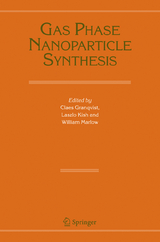Gas Phase Nanoparticle Synthesis
Seiten
2004
Springer-Verlag New York Inc.
978-1-4020-2443-6 (ISBN)
Springer-Verlag New York Inc.
978-1-4020-2443-6 (ISBN)
Intended for researchers and research students in nanomaterials science and engineering, condensed matter physics and chemistry, and aerosol science, this book deals with gas-phase nanoparticle synthesis. It fills the gap in the literature by addressing certain fundamentals of gas-phase nanoparticle synthesis.
"Nanotechnology" isa broad term that includes aspects of materials science,mesoscopicphysics, organicandinorganicchemistry, na- electronics, atmosphericchemistry,airpollution, and other?elds. The technology is very muchincurrent focus-at the beginning of the Third Millennium-and raises hopes for environmentally benign, resource-lean manufacturing of products of manykinds. One precursor to present-day nanotechnology used porous coatings, comprised of "ultra?ne" particles withdimensions inthe nanometer range, for absorption of thermal radiation on thermocouples, bolometers, and the like. These particles were prepared by gas-phase syntheses, speci?cally using species formed by nucleation andgrowth from a metalvapor - dergoing coolingby collisions withinert gas molecules. Such "inert gas evaporation" was explored inthe 1920s and 1930s [see, for example, A.H. Pfund, Phys. Rev. 35 (1930) 1434]andwas investigated in moredetail in the 1960s and 1970s [see, for example,K. Kimoto et al., Jpn. J. Appl. Phys. 2 (1963) 702; C.G. Granqvist and R.A. Buhrman, J. Appl. Phys.47 (1976) 2200].
Improved analytical capabilities(electron microscopy)as well as new applications (selective absorption of solar energy) were twoofthe r- sons for the renewed interest. Today, gas-phase synthesis of nanoparticles constitutesthe foundation for a pro?table butstill small industry. Aerosols, i.e., dispersions or suspensions of particles ina gas, form the background ?eld for contemporaryefforts in gas-phase nanotechnology. Interest inaerosol researchhistorically arose from the issues of atmospheric chemistry and physics, human health protection, and airpollution. Today, aerosol researchengagesa vast array of efforts inthese and related ?elds, andelsewherein work identi?ed as nanotechnology.
"Nanotechnology" isa broad term that includes aspects of materials science,mesoscopicphysics, organicandinorganicchemistry, na- electronics, atmosphericchemistry,airpollution, and other?elds. The technology is very muchincurrent focus-at the beginning of the Third Millennium-and raises hopes for environmentally benign, resource-lean manufacturing of products of manykinds. One precursor to present-day nanotechnology used porous coatings, comprised of "ultra?ne" particles withdimensions inthe nanometer range, for absorption of thermal radiation on thermocouples, bolometers, and the like. These particles were prepared by gas-phase syntheses, speci?cally using species formed by nucleation andgrowth from a metalvapor - dergoing coolingby collisions withinert gas molecules. Such "inert gas evaporation" was explored inthe 1920s and 1930s [see, for example, A.H. Pfund, Phys. Rev. 35 (1930) 1434]andwas investigated in moredetail in the 1960s and 1970s [see, for example,K. Kimoto et al., Jpn. J. Appl. Phys. 2 (1963) 702; C.G. Granqvist and R.A. Buhrman, J. Appl. Phys.47 (1976) 2200].
Improved analytical capabilities(electron microscopy)as well as new applications (selective absorption of solar energy) were twoofthe r- sons for the renewed interest. Today, gas-phase synthesis of nanoparticles constitutesthe foundation for a pro?table butstill small industry. Aerosols, i.e., dispersions or suspensions of particles ina gas, form the background ?eld for contemporaryefforts in gas-phase nanotechnology. Interest inaerosol researchhistorically arose from the issues of atmospheric chemistry and physics, human health protection, and airpollution. Today, aerosol researchengagesa vast array of efforts inthese and related ?elds, andelsewherein work identi?ed as nanotechnology.
1 van der Waals Energies in the Formation and Interaction of Nanoparticle Aggregates.- 2 Effect of Thermoporesis on 10-NM-Diameter Nanoparticles in Gas Flow inside a Tube.- 3 Key Effects in Nanoparticle Formation by Combustion Techniques.- 4 Basics of UV Laser-Assisted Generation of Nanoparticles Chemical Vapour Deposition, and Comparison with UV Laser Ablation.- 5 Nanoparticle Formation by Combustion Techniques Gas-Dispersed Synthesis of Refractory Oxides.- 6 Electron Diffraction from Atomic Cluster Beams.
| Erscheint lt. Verlag | 10.12.2004 |
|---|---|
| Zusatzinfo | X, 186 p. |
| Verlagsort | New York, NY |
| Sprache | englisch |
| Maße | 155 x 235 mm |
| Themenwelt | Naturwissenschaften ► Chemie ► Technische Chemie |
| Technik ► Maschinenbau | |
| ISBN-10 | 1-4020-2443-6 / 1402024436 |
| ISBN-13 | 978-1-4020-2443-6 / 9781402024436 |
| Zustand | Neuware |
| Informationen gemäß Produktsicherheitsverordnung (GPSR) | |
| Haben Sie eine Frage zum Produkt? |
Mehr entdecken
aus dem Bereich
aus dem Bereich
erneuerbare Energien und Speichertechnologien für die Energiewende
Buch | Softcover (2023)
De Gruyter Oldenbourg (Verlag)
69,95 €
Daten, Formeln, Normen, vergleichende Betrachtungen
Buch | Softcover (2024)
Europa-Lehrmittel (Verlag)
38,90 €




